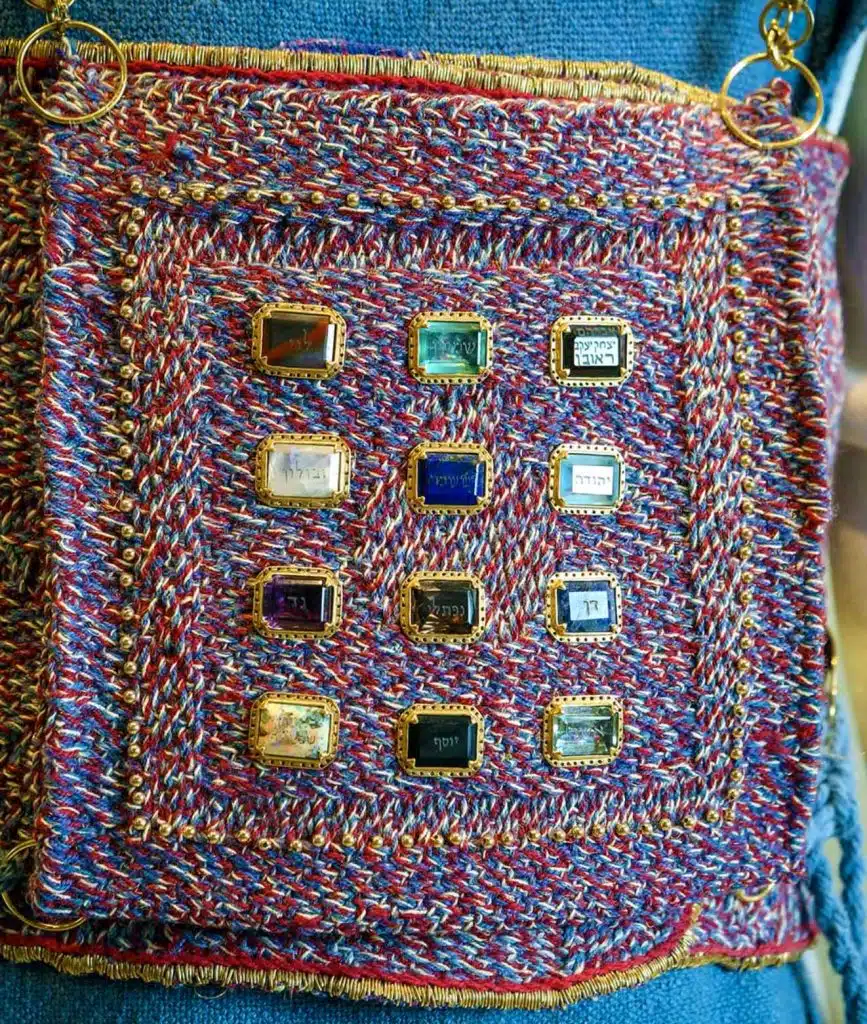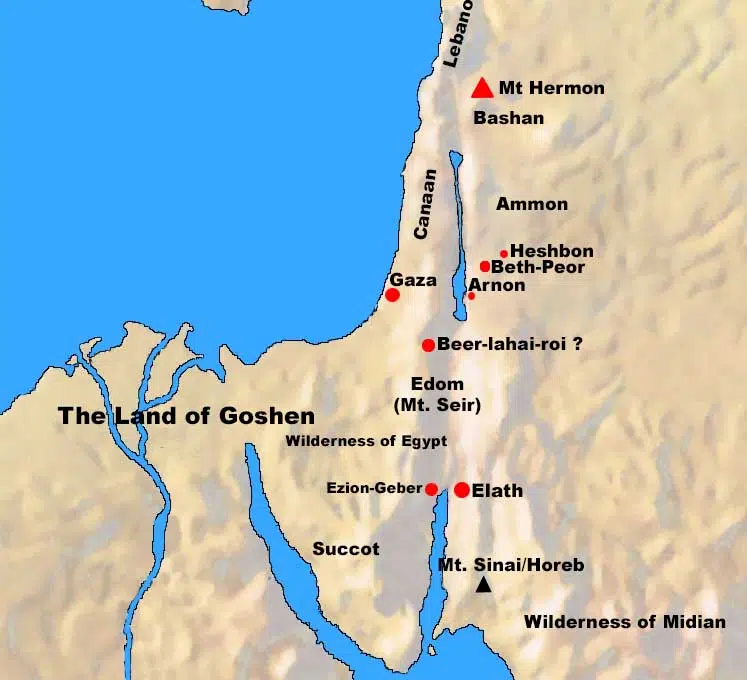Along with the ephod, the high priest wore a breastpiece. It was made of the same material as the ephod and had twelve stones arranged in four rows on it. Other items associated with the breastpiece were also built. The design of the breastpiece was given in Exodus 28:15 – 30.
The next piece of the high priest’s wardrobe was the breastpiece. This was referred to as “the breastpiece of judgment” in Exodus 28:15. The word for “judgment” (Heb. “mishpat”) is omitted here. The breastpiece (Heb. “khosen,” used only in Exodus 25 – 39 and once in Leviticus 8:8) is thought to be a pouch-like piece of clothing. Because of its importance, it had to be the work of a skillful workman, like the workmanship of the ephod. It was made of gold and of blue and purple and scarlet material and fine twisted linen, just like the ephod (Exodus 28:6).

According to Exodus 28:29, Aaron wore the breastpiece over his heart when he entered “the holy place, for a memorial before the LORD continually” as he ministered in the Holy of Holies.
That the breastpiece was a very important item can be seen in the fact that Exodus 28:15 – 30 has sixteen verses describing its design, and this passage (Exodus 39:8 – 21) devotes fourteen verses describing its construction. Its purpose can be seen in the term “breastpiece of judgment.” The “judgment” here does not refer to courtroom-style judgment. Instead, it involves making decisions and relaying the counsel and will of the LORD to the people.
It may have been a part of God’s means of answering questions asked of Him, (as in Judges 1:1, 20:18,23,27-28) where they “inquired of the LORD” and the LORD answered. Exodus 28:30 says the “Urim and the Thummim” should be kept in the breastpiece, perhaps in a pouch. The Urim and Thummim were apparently used to discern God’s will (see commentary on Exodus 28:29-30 for more on the Urim and Thummim).
The breastpiece was constructed as follows:
- First, it was square.
- It was folded double.
- Its size was a span long and a span wide when folded double. A span equaled around eight inches (25 centimeters).
- Once made, they mounted four rows of stones on it.
- The first row was a row of ruby, topaz, and emerald.
- The second row, a turquoise, a sapphire and a diamond.
- The third row, a jacinth, an agate, and an amethyst.
- The fourth row, a beryl, an onyx, and a jasper.
- All of the stones were set in gold filigree settings when they were mounted. A filigree was a piece of intricate metalwork, so the stones were placed into these metal settings and attached to the breastpiece.
The significance of the arrangement was that the stones were corresponding to the names of the sons of Israel. The fact that they were twelve, corresponding to their names, engraved with the engravings of a signet, each with its name for the twelve tribes, was a sign that all twelve tribes were precious and valuable in the LORD’s eyes. They were all part of the people He chose, because He loved them, and because of their forefathers (Deuteronomy 7:8). And they were all participants as vassals in the covenant. Also, the names of all of the tribes of Israel would be close to the heart of the high priest when performing his duties.
Along with the breastpiece itself, they made on the breastpiece chains like cords. These chains were made of twisted cordage work in pure gold. They must have been quite beautiful.
In order to attach the breastpiece to the other priestly garments:
- They made two gold filigree settings and two gold rings. The filigree was artful and intricate metalwork.
- They then put the two rings on the two ends of the breastpiece from which to hang it.
- Then they put the two gold cords in the two rings at the ends of the breastpiece. This would create a sort of double necklace for the priest to wear, except instead of being hung around the priest’s neck, it was attached to the shoulder pieces.
- Next, they put the other two ends of the two cords on the two filigree settings, and put them on the shoulder pieces of the ephod at the front of it. This means that the breastpiece was attached to the shoulder straps associated with the ephod.
- They made two gold rings and placed them on the two ends of the breastpiece, on its inner edge which was next to the ephod. The two gold cords of v. 17 were attached to the two gold rings at the left and right ends of the breastpiece.
In addition to the gold on the top of the breastpiece, they made two gold rings and placed them on the bottom of the two shoulder pieces of the ephod. It was placed on the front of it, close to the place where it joined, above the woven band of the ephod. This ensured that the breastpiece would rest on the chest (over the heart) of the high priest.
To complete the assembly of the breastpiece, they bound the breastpiece by its rings to the rings of the ephod with a blue cord. This was done so that it would be on the woven band of the ephod. The blue cord would provide an additional tether to secure the breastpiece so that it would not come loose from the ephod. The design apparently made the breastpiece secure rather than rattling around as the priest moved. This design would facilitate the priest’s work in the tabernacle. He wasn’t supposed to be on display, but rather to work actively to perform services of intercession on behalf of the people he served.
Again, the people crafted these items just as the Lord had commanded Moses.
Biblical Text
8 He made the breastpiece, the work of a skillful workman, like the workmanship of the ephod: of gold and of blue and purple and scarlet material and fine twisted linen. 9 It was square; they made the breastpiece folded double, a span long and a span wide when folded double. 10 And they mounted four rows of stones on it. The first row was a row of ruby, topaz, and emerald; 11 and the second row, a turquoise, a sapphire and a diamond; 12 and the third row, a jacinth, an agate, and an amethyst; 13 and the fourth row, a beryl, an onyx, and a jasper. They were set in gold filigree settings when they were mounted. 14 The stones were corresponding to the names of the sons of Israel; they were twelve, corresponding to their names, engraved with the engravings of a signet, each with its name for the twelve tribes. 15 They made on the breastpiece chains like cords, of twisted cordage work in pure gold. 16 They made two gold filigree settings and two gold rings, and put the two rings on the two ends of the breastpiece. 17 Then they put the two gold cords in the two rings at the ends of the breastpiece. 18 They put the other two ends of the two cords on the two filigree settings, and put them on the shoulder pieces of the ephod at the front of it. 19 They made two gold rings and placed them on the two ends of the breastpiece, on its inner edge which was next to the ephod. 20 Furthermore, they made two gold rings and placed them on the bottom of the two shoulder pieces of the ephod, on the front of it, close to the place where it joined, above the woven band of the ephod. 21 They bound the breastpiece by its rings to the rings of the ephod with a blue cord, so that it would be on the woven band of the ephod, and that the breastpiece would not come loose from the ephod, just as the Lord had commanded Moses.
Check out our other commentaries:
-
Galatians 1:18-24 meaning
Paul is still establishing his authority and the authenticity of the gospel he preaches....... -
Genesis 23:1-4 meaning
Sarah dies at the age of 127 years. Abraham mourns for his wife Sarah and then begins to look for a burial site for her....... -
Romans 6:21-23 meaning
Paul is asking the Roman Christians: What good did it do for you to live in sin? Was it really good? It kept you from...... -
Deuteronomy 7:17-19 meaning
Using the exodus experience as the basis of the reassurance, Moses commands Israel not to fear the inhabitants of Canaan, regardless of their numerical superiority. ...... -
Exodus 39:32-43 meaning
Verses 32 – 43 contain an inventory of the materials used to make the tabernacle and its furnishings. It signaled the completion of the tabernacle......



